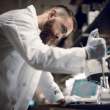Our Manifesto
There's an old saying about how you don't know what you don't know...
That was especially true for us when two months ago, we decided we would go about analysing the root cause of global plastic pollution... while still in high school.
At the time, it definitely seemed like a good idea full of smooth sailing! Now, we can reflect back on all the hidden surprises that came up and recognize that we really didn't know what we didn't know. That being said, through dozens of meetings with entrepreneurs and researchers in this industry, reading more reports than we can count, and publishing everything from a website to a podcast on plastic pollution - we've had our share of surprises on the status quo of this major problem.
The most surprising thing we figured out, however, was the number of people who could also find new insights from the research we did! We don't just mean high school students not knowing what they were getting into. We mean a surprising number of organizations that have been working to solve plastic pollution for decades!
While it did take us a month of unexpected pivots, we now feel that we're a lot more aware of several counter-intuitive aspects of plastic pollution: all the surprising causes that still mean plastic pollution is a growing problem after decades of work. We're not experts, but we're very passionate about making a difference in this problem that still continues to be a bigger deal in our lifetimes! And we really believe we can share some valuable ideas with organisations working to address this issue.
We hope to spark a new tide of action that gets well-intentioned organizations around the roadblocks they've been facing when trying to solve symptoms of the issue without addressing its root causes. But if nothing else, we hope these ideas at least shift the conversation so we can figure out how much we don't know and how much more we'll have to learn to finally get over this massive issue.
- Ayleen & Madhav, The Plastic Shift
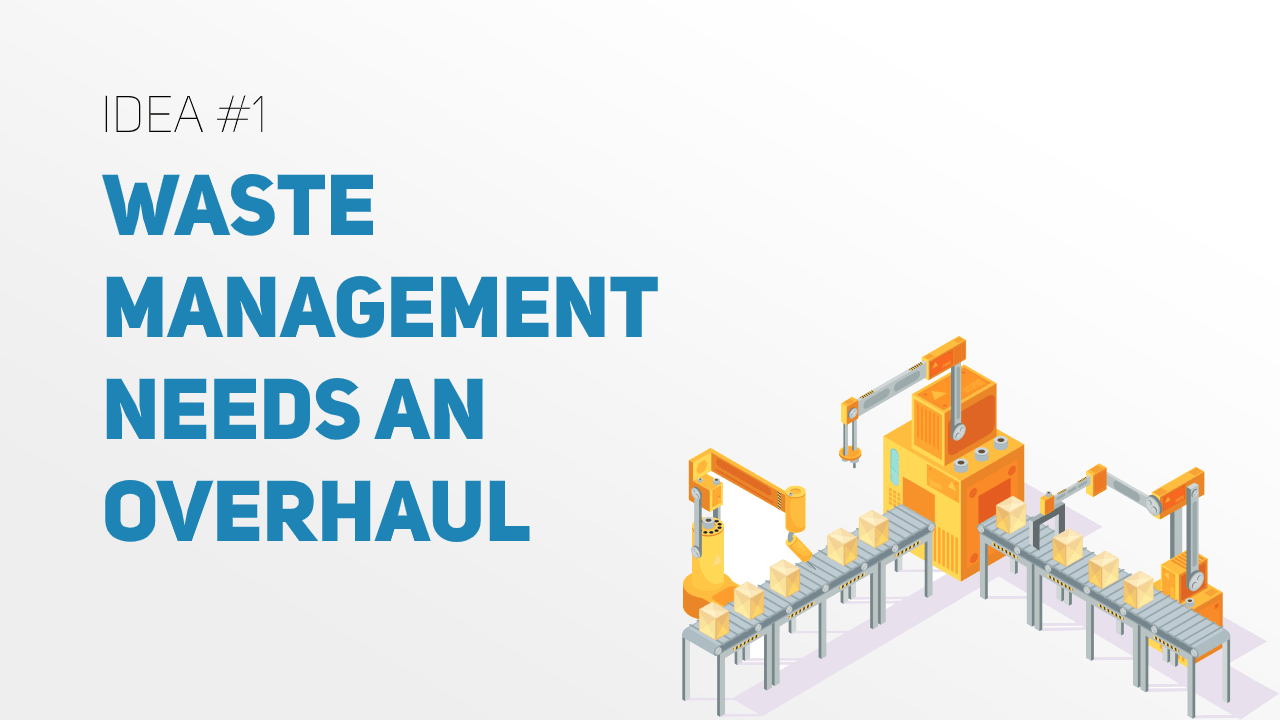
1. Waste Management Needs an Overhaul
-
1.1 So Obviously, We Have Recycling
Madhav: While there are many waste management technologies that are better for the environment than landfills (or worse, open dumps), the most common is recycling. Most organisations that try to make waste management systems more environmentally friendly try to increase the amount of waste that is recycled (in 2015, 19.5% of waste was recycled globally - (Source)
This is effective since recycling is generally seen as the most environmentally friendly waste management technology when it comes to changing the industry in the long term, although exact statistics vary (Source). It is important to note that in the short term, however, other technologies may prove to be more scalable or cost-effective (as I'll talk about in the next section).
With that said, some of the best areas to support when it comes to improving recycling are:
- Reducing contamination in plastics for recycling facilities via consumer education (Source) or better processing techniques (Source). A surprising amount of plastics that are sent to recycling facilities are diverted to other waste management facilities (like landfills) due to contamination. For instance, Waste Management (the company) sends about 25% of the plastics it receives for recycling to landfills due to contamination (Source). This is often due to improper recycling by consumers (ex. like putting products with food residue in recycling), which is why it's important to either educate consumers on proper recycling standards or develop processing techniques that can address this contamination (Source).
- Investing in the development of alternative processing technologies and materials for plastic types that are typically not recycled. There are many challenges when it comes to recycling certain types of plastic (like LDPE found in plastic bags or different plastic layers mixed together in multilayered plastics) and shapes of plastic (like thin films in packaging) (Source). In fact, 95% of the material value of plastic packaging is currently not recovered due to downcycling or disposal (Source). This could be addressed via further developing alternative waste management technology or alternative materials (Source).
- Lobbying for policies to increase recycling collection and processing infrastructure in local municipalities (Source). This is especially true when it comes to supporting policies like Extended Producer Responsibility, which involve private enterprises with the collection and processing of the waste they produce. This can increase efficacy and access to recycling programs (which is especially limited in rural areas. For instance, 40% of Americans in rural areas have access to curbside recycling vs. 70% of Americans in other areas).
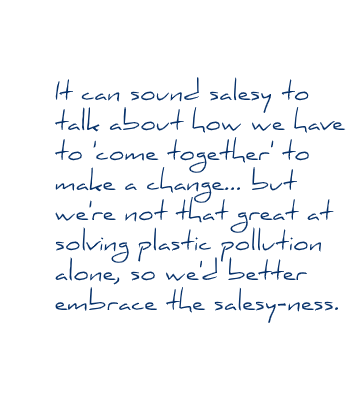
-
1.2 The Waste to Energy Situation
As mentioned earlier, however, there are other waste management technologies besides recycling that may not be the most environmentally friendly option in the long term, but have other advantages. Many of these alternatives fall under waste-to-energy (WtE) systems. These essentially burn plastic (and other) waste/fuels made from this waste to produce energy.
There are different types of waste-to-energy systems, such as incineration (just burning plastic waste), gasification (turning plastic waste into gas which can be burned), or pyrolysis (turning plastic waste into petroleum fuel products). The most common is incineration though. It's a viable alternative for recycling in the following contexts:
- It works with all types of plastic (and other) waste regardless of type and shape.
- It can function at very high volumes of waste with lower costs to scale.
That being said, there are also key downsides when it comes to incineration technology (Source):
- Incineration plants have high investment costs and are need to operate for several years before they're profitable
- If proper environmental standards are not met, they can create toxic pollutants as byproducts.
- They can divert investment away from recycling, which is a better long-term solution (Source).
Given all these challenges, it only makes sense to promote waste-to-energy systems in specific contexts. To enable this technology to be utilised to most sustainably address plastic pollution, organisations should support:
- Lobbying for policies to ensure existing and new incinerators meet environmental standards (especially with incinerators being constructed in developing countries - Source). Often, the implementation of incineration facilities has led to challenges in preventing toxic emissions like dioxins in developing countries like India (Source).
- Enabling incineration in joint with recycling systems, especially for waste that usually isn't recycled (such as thin-film plastics). This will prevent large proportions of plastic waste from ending up in the land fill (which has worse environmental consequences).
-
1.3 Leaving Behind the Typical Uses
Regardless of whether waste-to-energy systems or recycling systems are used, there are some key limitations that come about from melting/burning plastics specifically. With recycling, plastics are melted to be reformed into new products, but this doesn't work for all types of plastics (their chemical structure degrades and downcycles the quality of the plastic - Source). And with incineration, burning the plastics leads to harmful toxins being that need to be dealt with and you lose the material's value in the process (Source).
But there are alternative ways to repurpose plastic, from using recycled plastics in composites with other substances to create construction materials like bricks/pavement to using recycled materials to make decorative products for consumers. The core issue with all of these efforts is that they don't scale to achieve large impact (diverting a large quantity of plastic waste from landfills).
That being said, there is some promise for a few of these products. Especially when it comes to construction materials such as plastic tiles, they can be cheaply produced in developing countries with further development. In general, this type of waste management technology can be best supported in the following ways:
- As solutions for alternative materials in informal economies (especially in developing countries). For instance, plastic composite construction materials are useful in areas like the slums of Dharavi (India). The production of typical materials in informal settlements like this is poor and replacing typical materials with such alternatives could support low-wage workers, increase the quality of construction, and displace plastics from ending up in open dumps. That being said, only a few recycled plastic-based materials are currently economically feasible.
- Via initiatives to support the research and development of these materials to improve their scalability. Many types of alternatives for repurposing plastics have high unit costs, which make them hard to grow in impact (displacing plastic waste from landfills). This could be addressed by further developing production processes with low material costs or creating markets driven by the social benefits of these materials (instead of purely the profit margins of whatever material is cheapest, as is typically the case in industrial markets).
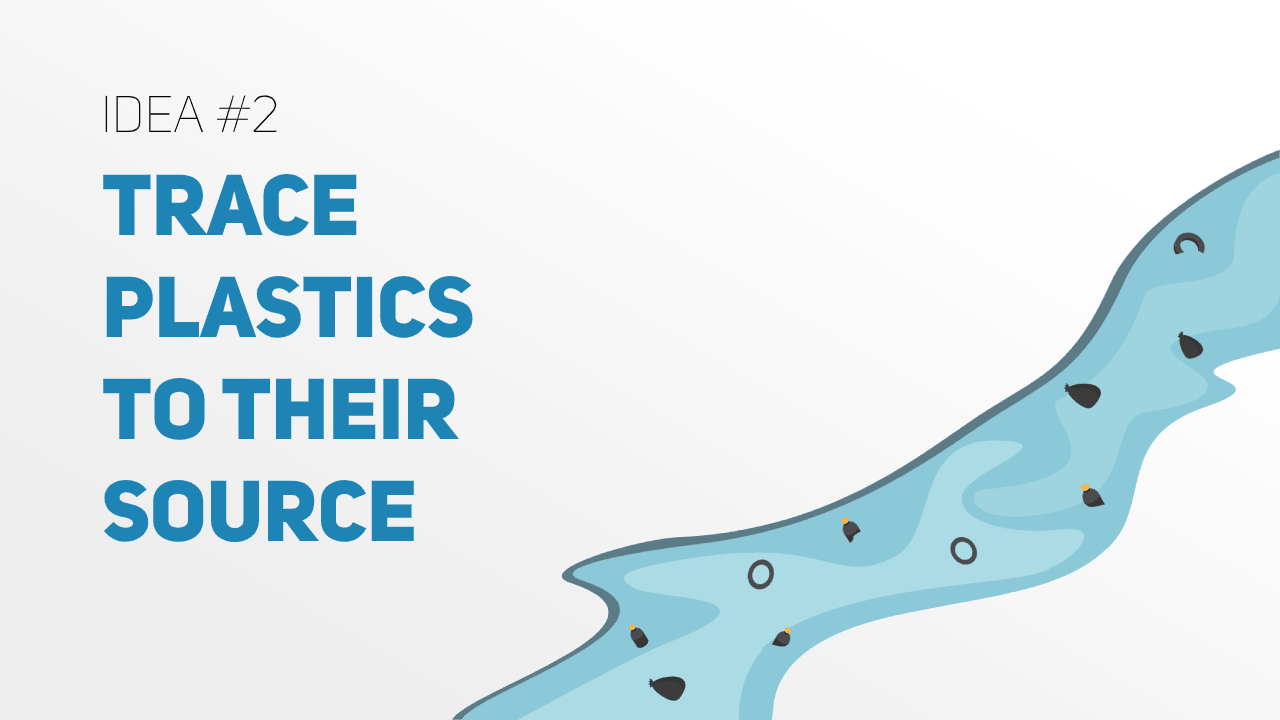
2. Trace Plastics to Their Source
-
2.1 Plastic Generation In Numbers
Ayleen: Plastic pollution has become one of the most pressing environmental issues in the world. And yet, every year, the production of disposable plastic products drastically increases as a result of lower oil and gas prices– it’s come to a point where the amount of plastic generated is far too overwhelming for the world to actually deal with it. To help give you some context on the situation, here are some statistics regarding the generation of plastics:
- Plastic production reached 448 million tons by 2015. The World Economic Forum predicts this number will double in the next 20 years.
- Half of all plastics ever manufactured have been made in the last 15 years.
- Every year, about 8 million tons of plastic waste escapes into the oceans from coastal nations.
- There’s approximately 51 trillion microscopic pieces of plastic in our oceans, weighing 269,000 tons total. This number is more than 500 times the number of stars in our galaxy.
- Plastics consistently make up 60 to 90% of all marine debris studied and have been found in 100% of marine turtles, 59% of whales, 36% of seals and 40% of seabird species examined.
In fact, around 66% of all plastics end up moving into the sea directly from land based sources. People leave litter on the beaches, throw them on the side of the road (where the plastic can flow through drains into the ocean), industry spills, badly managed landfill sites, ships/boats at sea, containers that go overboard – you name it. It’s a compounding issue that has been the result of millions of individuals, families, companies, and governments’ laziness to take action.
-
2.2 Cleaning The Ocean Isn't Effective
You don’t need an expert to understand that cleaning up marine debris found in the open ocean is not as simple as it may sound. Take the great Pacific garbage patch, for example, a huge pile of plastic in the middle of the ocean that spans 1.6 million square kilometres – there are 80,000 metric tonnes of plastic in the patch, which is around 1.8 trillion plastic pieces. While the task itself seems almost impossible already, the plastics are constantly shifting as a result of ocean currents and the majority of pieces are microplastics (less than 5mm in size).
While numerous startups and organizations have been trying to reduce the size of the ever-growing garbage patches across the world, efforts to clean the ocean aren’t actually solving the root cause of the problem. By focusing on ocean cleanup, we’re moving the proposed solution to a distant location, where the trash is, rather than into our own lives, where the trash is being generated. I’d say we’re even detaching ourselves from the problem. The garbage patch seems so distant that it doesn’t seem like our problem anymore – and it’s easy to become complicit in contributing to plastic waste generation.
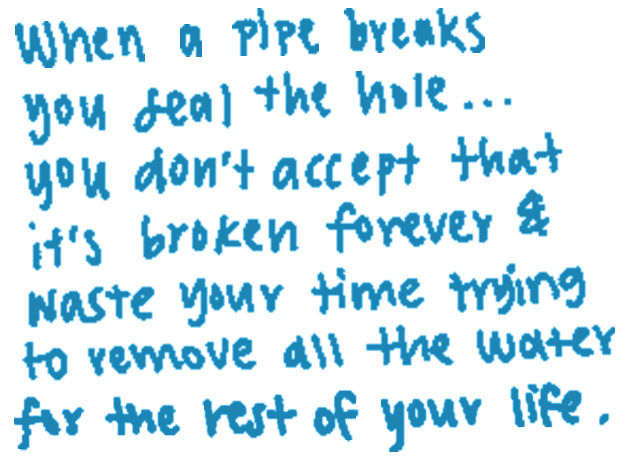
From the 31.9 million tonnes of mismanaged plastic waste near coastlines, 8 million tonnes end up in the oceans. This is about 2.9% of all plastic waste (which was 275 million tonnes / year in 2010). An even smaller subset of this plastic ends up in surface waters, which is where ocean cleanup efforts are focused (under 0.4% of all plastic waste). So what about all of the rest of the plastic? If we could somehow clean our oceans, there'll still be so much more plastic waste that countries would have to deal with. It'll be more worth it to intervene at an earlier stage in the process where we could have a higher impact on the problem.
But even if removing 2.9% of plastic waste reduces its environmental impact by a substantial amount, the feasibility of cleaning our oceans is far too low. How could we even begin cleaning billions of pieces of tiny microplastics floating around in the water? Even if we could create a technology that could capture plastics of all sizes, just look at the size of this area. Scientists did some calculations and estimated that if you tried to clean up less than one percent of the North Pacific Ocean it would take one year for 67 ships to clean up that portion, although there are more promising alternatives being developed. And the bottom line is that the patch will just keep on growing bigger. Until we prevent debris from entering the ocean at the source, it’ll be a vicious cycle that’ll grow worse and worse every year. Unless we stop plastic generation, the problem will never end.
-
2.3 What Should We Do?
If we want to really need to make an impact, we need to support the Circular Economy model (that is, support an economy where all resources can be reused with no waste generated). The main components of this idea are that:
- The production of virgin plastics should end. Instead, if new materials are needed, other alternatives or recycled should be used.
- Building off of the first point, plastics should be redesigned so they can be reused
- We should circulate EVERYTHING. Every product should stay in the economy without ever becoming waste or pollution.
Obviously this model is naive in the sense that it's almost impossible to satisfy all of these components. But the circular economy should definitely be a part of our future.
If we adopt this model on a global scale, the economic benefits are substantial. According to the United Nations Environmental Plan, the economy would benefit $2 trillion a year from more effective resource management due to lower costs of raw materials and increases in employment and innovation. The development, production and maintenance of circular products would require a specialized workforce. Yet, by having a lower demand for the extraction and processing of raw materials, we’ll be able to get rid of unspecialized jobs in the workforce - thus increasing the value of labour while benefiting employment.
But what about the environmental impacts? According to calculations done by the Circle Economy, 62% of global greenhouse gas emissions (excluding those from land use and forestry) come from the extraction, processing and production of goods to meet society's demands. If we got rid of producing goods entirely, these global greenhouse gas emissions should drop drastically. Take the European Union, for example, where emissions from industry would fall by 56% in 2050 if they were to implement the circular economy.
Also in Europe, a circular approach to our food systems can lead to an 80% reduction in the use of artificial fertilizers. The Ministry of Agriculture, Nature and Food Quality's Vision on Agriculture, Nature and Food: Valuable and Connected states that the future of our food supply can only be secured if we switch to recycled agriculture. Not only will this have a lower environmental impact than our current situation with plastics, but there's so many other industries that will be positively affected as well.
To make the circular economy a reality, NGOs should identify alternatives to plastic that are more environmentally friendly (without posing any health risks on humans either), consider transitioning strategies to shift away from plastics, and recognize particular industries that contribute more significantly to the plastic waste problem so that more efforts can be made to solve the problem within these industries for the sake of having the most impact.
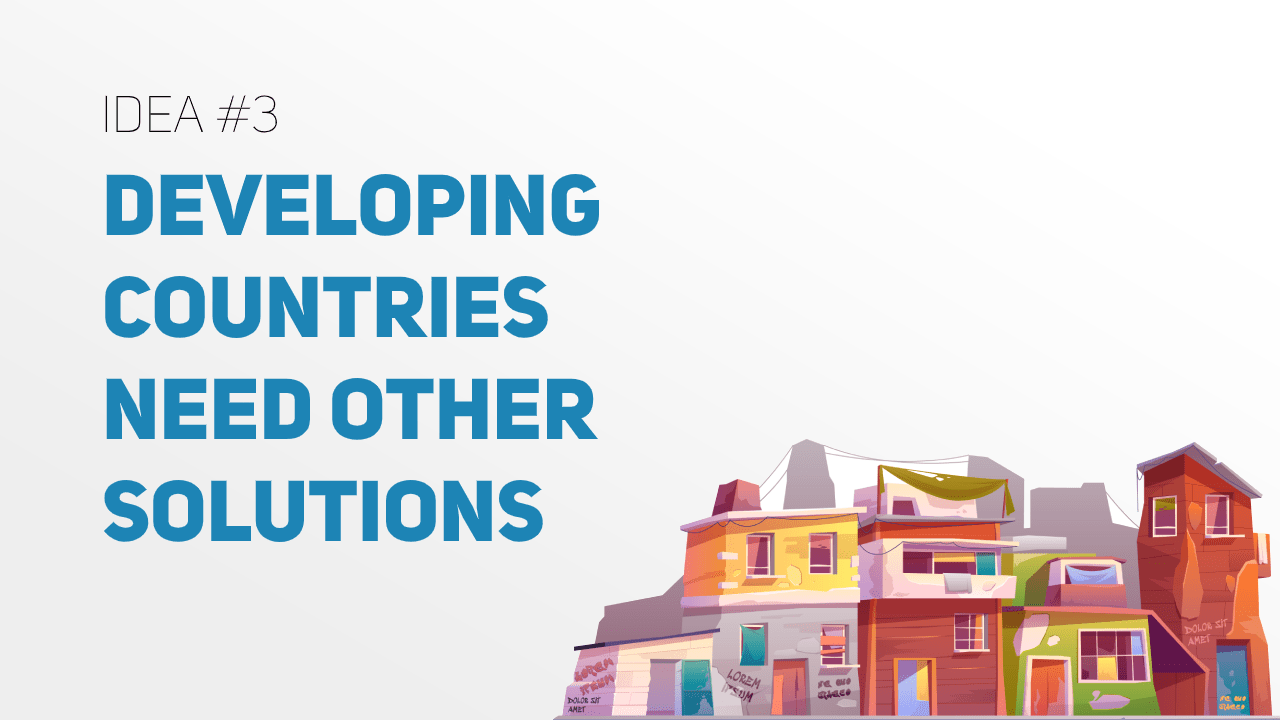
3. Developing Countries Need Other Solutions
-
3.1 Why Developing Countries Need More Help
Madhav: When it comes to solving plastic pollution, we think of banning single-use plastics in fast food chains or improving machinery in shiny recycling facilities. The reality, however, is that over 80% of mismanaged plastic waste is found in developing countries in Asia (Source). And the issues in these countries are often different from the issues in developed countries. Instead of implementing single-use plastic bans and improving recycling machinery, the most effective solutions might be to help organize the informal waste management sector or improve open dump infrastructure (Source).
Therefore, the majority of plastic pollution comes from developing countries and they have unique challenges that are different from developed countries. Also, the challenges vary from one developing country to another. This is why solutions to improve the waste management industries in developing countries warrant more attention; they can have a large impact and they're unique. Some major problems that need attention in developing countries are:
- Improving work standards and economic sustainability for informal waste collectors, who currently only collect 20% of waste from open dumps (Source). When it comes to the work standards, informal waste collectors face several issues including exposure to biohazardous waste, social stigma, and poor tools for processing waste. As for economic incentives, a lack of market organisation often limits the profitability of waste collection. This makes waste collectors leave more waste in open dumps where it can leak into the environment. There are business models that allow organisations to organise informal waste collectors, while addressing these problems (Source). These could be further funded or scaled to more regions still.
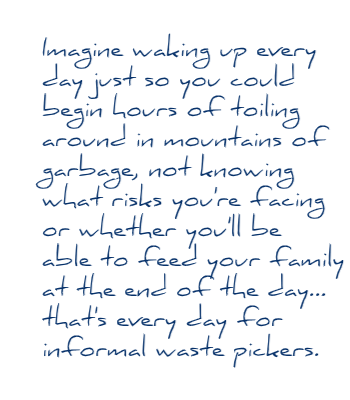
- Addressing open dump infrastructure to prevent waste from leaking into the environment. Up to 93% of waste ends up in open dumps in lower-income countries, which have poor enclosure from the surrounding environment (Source). This leads to chemicals and plastic leaking out into the surrounding environment (especially for open dumps near waterways, in countries like the Phillippines). This could be largely addressed via building better enclosures for open dumps and locating dumps away from waterways (Source). Projects like these again need greater funding (often, they aren't prioritised by local governments) and need to be scaled across developing countries (especially in Asia).
- Increasing consumer and producer awareness about adopting the usage of recyclable materials (especially non-multilayered plastics). First, multilayered plastics make up a large proportion of plastics in developing countries especially (up to 56% of plastic packaging - Source). These plastics are very hard to recycle, which leads to many of these plastics just being disposed of. Creating the right incentives for producers to use recyclable (or reusable) materials in their products when possible is essential. Then, even following a switch in the production of materials, consumers need to be educated on proper recycling practices (which can be a challenge given some case studies - Source)
-
3.2 But There are Still Issues in Developed Countries
Although plastic waste in developed countries most often does not become pollution due to formal waste management systems, a large proportion of waste still ends up in the landfill. In 2015, the global recycling rate was 19.5% (Source), although this varied drastically from 66.1% in Germany (Source) to 34.7% in the U.S. (Source). What happens to all the other waste? It mainly gets either sent to landfills or incinerators, both of which are less environmentally-friendly options.
So improving the recycling rates for developed countries would aid in lowering a country's environmental footprint, as well as potentially leading to economic savings from a lack of materials losses. The key ways to support the recycling rate are to support the other ideas we mention, such as improving waste management technology or adopting effective government policies.
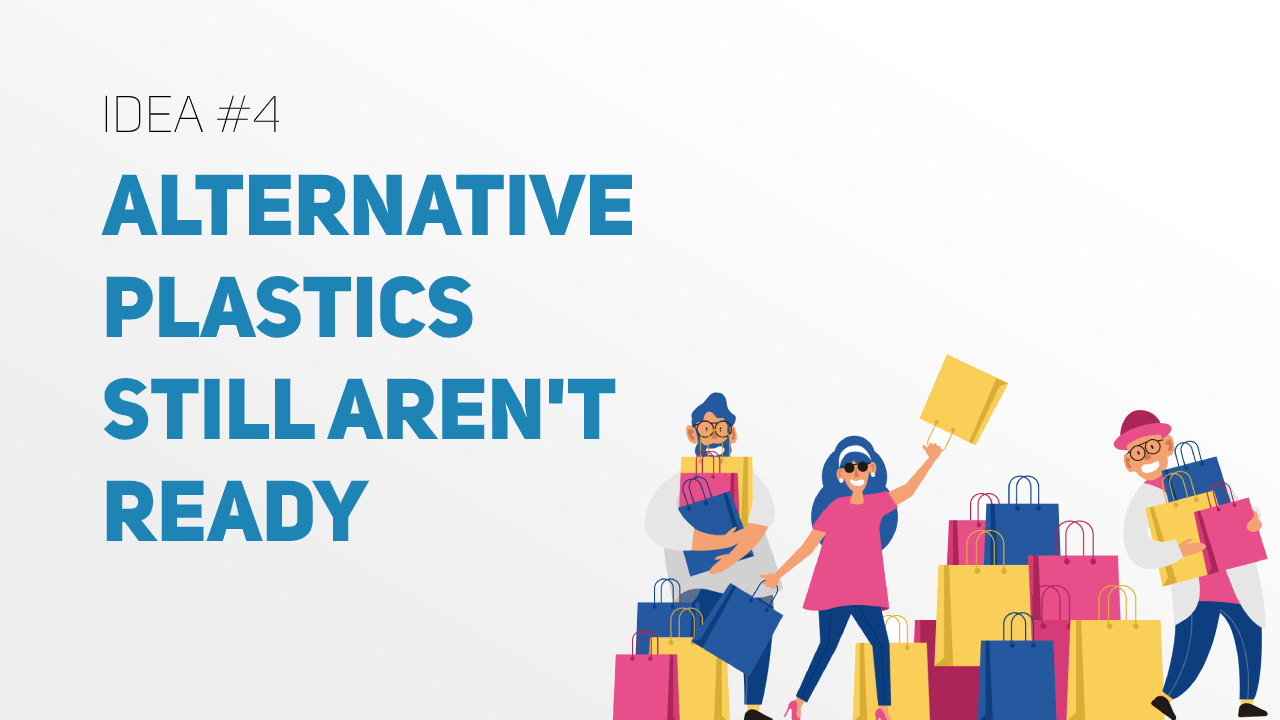
4. Alternative Plastics Still aren't Ready
-
4.1 The Big PR Lie
Ayleen: With all these huge corporations switching to paper bags or giving discounts for people who bring tote bags from home, you’d think plastic alternatives would be a viable solution to the plastic pollution problem. Sadly, a report from the Danish Environmental Protection Agency suggests otherwise.
According to the report, each plastic alternative needs to be reused numerous times to have as low of an environmental impact as single-use plastics. Cotton tote bags, for example, would need to be reused 7,000 to 20,000 times (depending on what type of cotton was used to manufacture the bag). I’m not sure about you, but the magnitude of the number made my jaw drop. Even the so-called “best” alternative, recycled polyester PET, would still need to be reused 35 times. When comparing these materials across all levels of pollution, it turns out that virgin plastic is still a much more “environmentally friendly” option (and I’m using that term very lightly).
That being said, once you think about it a bit more, the numbers begin to make sense. While marine life might not be dying from cotton consumption (as opposed to plastic consumption), the amount of resources needed to farm and harvest cotton has detrimental effects on the environment. Cotton’s most prominent environmental impacts result from the use of agrochemicals and pesticides, the consumption of water, and the conversion of habitat to agricultural use. And that’s just one of the alternative materials we’ve been using instead of plastics. The production of glass, for example, has even higher carbon emission rates than the production of plastic.
So if studies have proven that these alternative solutions do more harm than good, do companies know about it? Shockingly, yes. In fact, a report from Green Alliance stated that many businesses are beginning to make changes to “put the public at ease”. These corporations have admitted that they made the decision to switch to paper bags, for example, without fully considering all of the environmental consequences. There was even a quote from a representative that said: “We are aware that [by switching from plastic to other materials] we may, in some cases, be increasing our carbon footprint.” As a result, large corporations should not promote the switch to these so-called alternatives – nor should there be any investments into alternative materials without proper research on a comparison between the environmental impacts.

-
4.2 A Promising Future For Alternatives
That being said, not all hope should be lost. While more traditional plastic alternatives have been proven to not work, a newer solution has been gaining popularity: biodegradable plastics. So far, there have been problems with biodegradable plastics breaking down into microplastics and not fully decomposing in the ocean. Researchers have explained how plastics labelled biodegradable (eg. shopping bags) will only break down in temperatures above 50 degrees Celsius. But plastic bags sink in the ocean, making it impossible for them to come into contact with UV rays and reach high enough temperatures to degrade.
Even though researchers have been using "biodegradable" and "compostable" as buzzwords for their plastic materials, the names don't suggest anything about the material’s ability to break down quickly in natural environments. In a study conducted by the University of Plymouth, a compostable plastic bag disintegrated after being exposed to the air and when left to decompose in the sea, but was still present after being buried in soil for more than two years. Plastics are generally not designed to degrade without special treatment, which means they can be just as harmful as regular plastics derived from fossil fuels.
However, the technology has been advancing more recently – scientists are optimistic that this will become a viable solution within the next few years, whether it be as a replacement in supermarkets and stores worldwide, or in other applications such as agriculture and farming. We should continue investing in research on biodegradable plastics for the sake of finding an alternative but it's also important to not make the switch to biodegradable plastics until we're sure that the environmental impacts are less than virgin plastics.
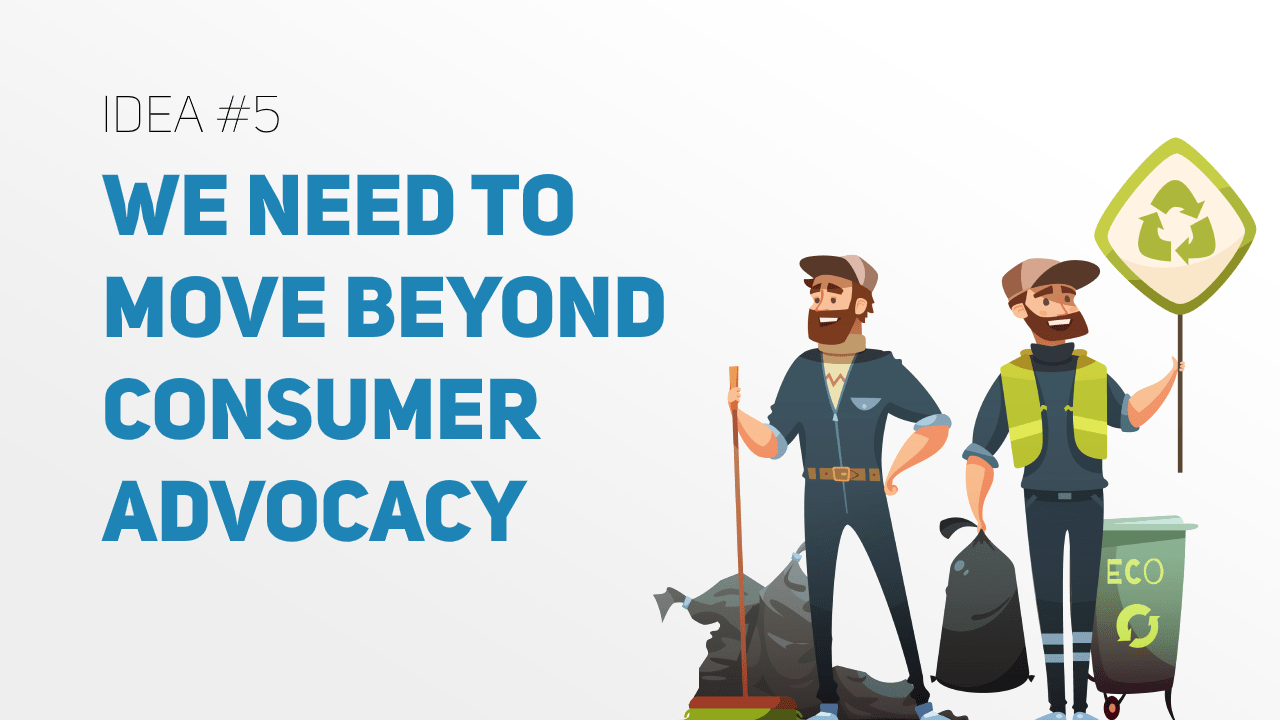
5. We Need to Move Beyond Consumer Advocacy
-
5.1 Unfortunately, Beach Cleanups don't Scale (and Don't Work When they Do)
Madhav: Many NGOs that are working on this issue tend to focus on rallying consumers to advocate for something, with the call-to-action ranging from lobbying for government policies to beach cleanups to refusing single-use products. Not all of these actions are the same in terms of efficacy.
As Ayleen mentioned in our second idea, cleaning the ocean isn't an effective solution to the overall plastic waste issue. And beach cleanups are mainly an unscalable way to clean the ocean, relative to automated solutions to this problem (Source). Comparatively, there might be more impact from refusing single-use products, but this is again not scalable at the individual level (Source).
When it comes to consumer advocacy, there is an effective impact to be had - but it's also very easy for NGOs to become bogged down in building supportive communities around ineffective actions that don't lead to tangible change. So what are beneficial areas to support in getting consumers to advocate for actions that actually matter?
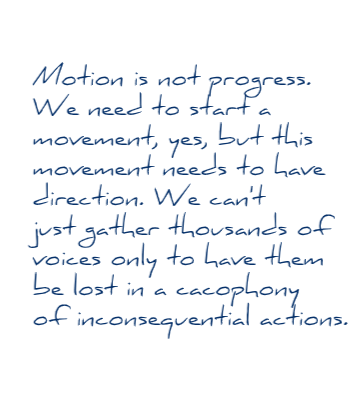
- Enabling consumers to get producers and commercial buyers of plastic to use reusable or recyclable materials. This is a relatively easy change for most NGOs to achieve in terms of their asks to consumers. For instance, instead of asking consumers to volunteer in beach cleanups, an NGO might work with volunteers to help local restaurants create a plastics-free week for CSR publicity. The major new action would be to develop partnerships with producers and commercial buyers of plastic to decrease single-use plastics with incentives like CSR publicity - like some organisations (Source) currently use.
- Creating widespread awareness of the root causes of plastic pollution. This is a challenging feat to accomplish, given that some of the most successful organisations that work with consumers prioritise easy-to-comprehend branding that doesn't lend itself to sharing a nuanced analysis (Source). Additionally, our team doesn't have much experience with branding and consumer outreach to identify feasible methods to build an informed community of consumers.
-
5.2 Plan B: Following the Money?
Now, there are benefits to working with consumers that don't involve building consumer awareness or using collective consumer advocacy to incentivise companies to create large-scale changes. These mainly involve the fact that consumers (in developed countries especially) have generous amounts of disposable income that they're willing to put towards organisations with a social incentive.
For instance, there are massively profitable businesses that sell Direct-to-Consumer (D2C) products (like jewellery or bracelets) made out of recyclable materials and use some amount of these profits to fund initiatives like cleaning waste plastics from the oceans (Source). Although cleaning the oceans isn't the best use of these profits in terms of making an impact, profits derived from D2C sales can be used to fund impactful initiatives as well (as long as these initiatives are branded well to incentivise consumers to support such initiatives by buying an organisation's products).
When it comes to selling products (whether it be for profit-driven businesses or nonprofit fundraisers), doing business with consumers has several benefits for an organisation (including lower price sensitivity and higher profit margins - Source). All these details in combination show an alternative method of involving consumers in creating a meaningful impact on plastic pollution.
The surprising reality is that making large profits from D2C sales can be a very altruistic thing... if we use these to fund the other ideas mentioned that have a large potential to solve this problem (like supporting organisations that invest in improving informal waste management systems in developing countries).
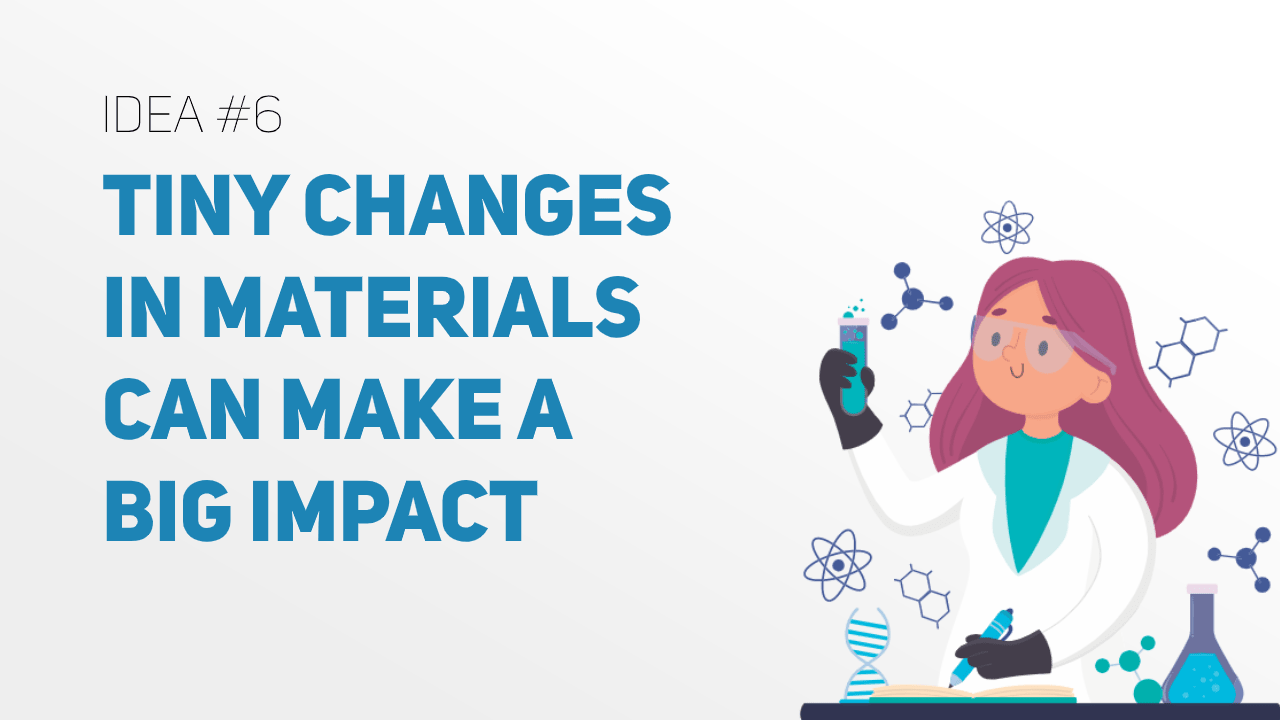
6. Tiny Changes in Materials can Make a Big Impact
-
6.1 Low vs. High Value
Ayleen: If you were to pay attention to the types of plastics generated and thrown to waste, you'd find that 80% of all plastics are considered low-value (according to the Ocean Conservancy). That is, after being used once, these plastics will lose quality each time that they're recycled. Rather than perpetuating the idea of a circular economy, low-value plastics are a contributing factor as to why we have to consistently produce more and more plastic materials to make up for demand instead of reusing existing products.
But why are these plastics actually losing quality? In order for plastics to be recycled, they must be melted down so that they can later be put into molds and reshaped into new products. With most plastic types, melting them down causes their structure to change at the molecular level. Every time low-value plastics are recycled, the quality decreases far too much to make the product viable at that point.
To make matters worse, low-value plastics generally won't even end up in a recycling facility in developing countries since waste pickers and workers have no incentive to pick up these plastics since they provide no financial value. Because of this, low-value plastic is the most common form of plastic that is found in mismanaged waste.
We need to create incentives for companies to replace low residual value plastics with recyclable plastics, although alternatives can sometimes lead to higher costs of production or transportation. For cleanup of low-value plastics that have already found its way into the environment or our oceans, some organizations have been creating these economic incentives for the collection of these low-value plastics, such as giving money to waste pickers who bring in a certain amount. Additionally, low value plastic has found its way into other industries, such as the generation of plastic lumber or plastic bricks, for example, but the quality of such materials are not always comparable to those made with virgin plastic. Even though the repurposing of this type of plastic can reduce the amount of waste in the environment, more research and time should be spent looking into better applications of the plastic – how do we improve these materials made of recycled low-value plastics so they're economically competitive with those made with virgin plastics and effective at fulfilling the purpose of what the product is supposed to do in the first place?
-
6.2 The Chemical Recycling Conundrum
As one of the latest fads for many corporations, chemical recycling still needs quite a bit more research before we can adopt this solution on a wider scale - but that doesn’t mean it’s impossible. For context on what the industry is currently dealing with, here are some of the bigger issues with the two main types of chemical recycling so far:
- Chemical depolymerization... requires an extremely large amount of energy. In order for the polymers to be broken down, the amount of heat needed depends on the input material – multilayer materials need more energy, for example. Not only are these amounts of energy costly, but they're also damaging to the environment. Additionally, there’s a high chance that the process involves the creation of potentially hazardous byproducts. Based on the majority of papers so far, it seems as though there's still a lot more research that has to be done regarding the side effects of chemical depolymerization. The question remains, is it actually safe for the environment? Finally, there’s the issue of price differentiation. Right now, chemically recycled polymers are still more expensive than virgin polymers. We’ll need to find enough sorted homogeneous plastic waste, infrastructure, and transport and we’ll need market intervention of some sort if we want this to be feasible according to Zero Waste Europe’s report.
- Solvent-based purification... can only deal with homogeneous flows of plastic. That means we’ll need an improved sorting system and large amounts of these sorted plastic if we want to implement this on a large scale. Zero Waste Europe’s report sums up the problem well: “The infrastructure and transport costs are also challenging: plastics are lightweight but production volumes need to be high”. According to them, we’ll need high capacity plants – at least about 10-20 kilotons – to make the investment pay off (and that itself is an expensive endeavour). Moreover, polymers need to be processed again to create the new plastic object, meaning polymer length will be shortened anyways. It seems inevitable that the plastics will be of poorer quality compared to its initial state before recycling. Then there’s also the issue of how the purity of the output polymer can vary according to the input – contaminants can greatly influence the quality of the resulting plastic.
Both of these types of chemical recycling call for a homogeneous flow of plastics, but how is that possible if our waste management system is lacking? Our current recycling systems are notorious. So yes, I don't think companies should be turning to chemical recycling just yet until we get the research down pat. There's too many factors that have yet to be resolved when it comes to the economics, logistics, and feasibility of this solution as well as the potential impacts that it might have on the environment. This idea and the general research in this field is still very new so it's best to not jump to conclusions out of excitement. Organizations should instead focus on improving our own waste management facilities. If these methods of chemically recycling plastics turn out effective in the next decade, we'll need proper waste sorting facilities to implement this solution.

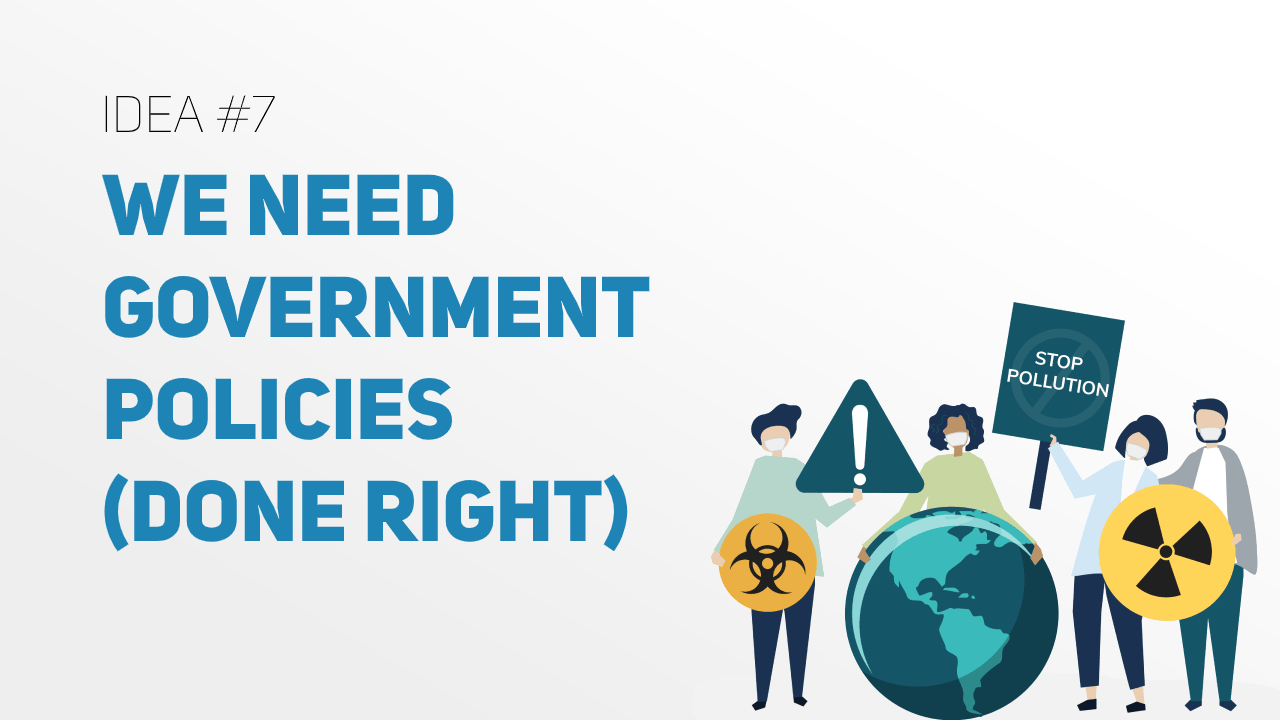
7. We Need Government Policies (Done Right)
-
7.1 The Government can Help... Others to Start Helping
Madhav: When it comes to the government helping solve massive problems in an effective manner, it seems like a far-off dream (especially in the current political climate). That being said, in the world of government policy - there is one effective solution currently spreading from Europe to North America. And it involves the government helping... others get involved in helping.
This policy is called Extended Producer Responsibility (EPR). It has existed in Europe for some time, but is only now starting to spread to North America. It involves producers taking responsibility for the end-of-life management of their products. Now, EPR policies have been around for a long time for products like batteries. They've only been implemented for product packaging (which makes up over 40% of all plastic waste - Source) more recently though.
Often, EPR programs involve producers paying municipalities some percentage of the costs of managing the waste created from those companies' products. Sometimes, legislation can range to Full Producer Responsibility, where companies are completely in charge of managing the waste from their products (not just paying municipalities to do it).
These policies have been very promising so far now that they're starting to be implemented in North America. For example, full producer responsibility for product packaging was implemented in British Columbia in 2014, where businesses decided to form a coalition called RecycleBC to manage their product waste together (Source). Since then, the program has succeeded in creating a recovery rate of 78% for materials used in member companies' products, a recycling rate of 87% of waste by weight, and getting 73% of residents to make an effort to recycle (Source).

This case study in North America shows that Full Producer Responsibility has several advantages including leading to more effective recycling technology and a more effective recycling industry, a greater ability to educate consumers collectively, and the improvement of waste management services in the province (all via greater market power due to organisation). Thus, for NGOs lobbying for government policies, Extended/Full Producer Responsibility is a tested means to create effective government action - while also enabling private companies to help address plastic waste.

8. Leaving Room to Learn What We Don't Know
-
8.1 The Great Toxicology Debate
Ayleen: When I first tried to Google search what were the effects of BPA on human health, I was met with conflicting article titles. "BPA levels in humans drastically underestimated, study finds" said one paper while another read "BPA might not be dangerous after all...". And, sure enough, far too little conclusive research has been done for us to truly know the effects of BPA.
So far, tests have found the chemical in more than 90% of Americans but we still don't know the risks on humans. Many say the variability in studies have been due to the fact that it's difficult to detect changes to the endocrine system, while others blame the conflict between scientists and regulators. According to an article in Science Magazine, there is a "deep rift between academic scientists and regulators about which kinds of studies are best for shaping government oversight of chemicals". All things considered, there have been a growing number of studies that explain how BPA has had negative health effects on rodents and other organisms. While we might not know whether these same effects were to occur on human, it's been enough for governments to implement policies to ban certain products containing BPA.
For example, baby bottles containing BPA were banned in the U.S. and European union. These types of policies, together with public awareness campaigns, have established a false sense of security surrounding plastic products in supermarket. While we might think that the majority of plastics are now BPA free, it's actually not the case – BPA is still found in many food containers, especially cans. Even when companies stop using BPA, they end up replacing it with other chemical compounds which might be just as toxic (or even worse). Bisphenol S (BPS) has become increasingly popular in recent years even though it shares much of the same chemistry as BPA. Unfortunately, companies are turning to alternative compounds without knowing any of the potential health risks these chemicals may pose on consumers.
While more research needs to be done on this topic, it doesn't mean companies should just ignore the issue of BPA and toxic chemicals in plastic products. NGOs working to resolve plastic pollution should also fund research in toxicology aspect of the problem. Even if we find a viable solution to end plastic pollution and generation, it'll take many years to fully resolve this issue. Thus, in the meantime, we'll need to make sure that the material is safe for humans.
-
8.2 The Not-So-Micro Problem With Microplastics
If you thought BPA and other chemicals in plastics are a major problem, then just wait until you hear about the amount of microplastics humans ingest. A research review published last year stated that Americans ingest at least 74,000 microplastic particles every year while another study conducted by researchers at the University of Newcastle in Australia estimated that people consume about 5 grams of plastic a week through the food we eat, the water we drink, and the air we inhale. So what has been the general research so far based on the different methods of microplastic consumption?
- Via drinking water. Microplastics have been identified in drinking water as small as 1 µm (there are likely even smaller pieces present but current technologies prevent us from being able to detect them). Because there's no proper filtration system in place, people who meet their recommended water intake through tap water ingest an additional 4,000 plastic particles annually. That being said, this number of particles seems small once you consider how those who drink bottled water only ingest an additional 90,000 microplastics each year.
- Via air. It's been found that microplastics are airborne. For example, in Paris, it is estimated that 3 - 10 tonnes of fibres are deposited on the city each year from the air. To make matters worse, microplastics were proven to be present inside of people's homes as well. Indoor concentrations were primarily found to be 3-15 particles per metre^3. Overall, it is estimated that around 20,000 pieces of microplastics are inhaled by a single person each year.

- Via food. This is particularly through seafood consumption since fish and other aquatic animals are more likely to ingest microplastics. Looking at California as an example, 25% of commercial fish processed there contained microplastics. However, a lack of research, there is insufficient information to assess the true amount of microplastics humans may be exposed to via food" (Study).
But what exactly are the effects of microplastics on humans? Microplastic particles can contain chemicals that are linked to harmful health effects such as cancer, weakened immune systems, and reproductive problems. The particles could even leach BPA, which interferes with both male and female hormones. While some organizations say that consumption of microplastics actually don't pose any health risks on humans, the Plastics Industry Association claims that more research needs to be done to assess the potential health effects.
So those are eight key ideas we found out about the hard way, when stopping to take stock of all the action that's been taken on this issue and why it's still around. We really do hope that organizations can use this information to take stock of how they can adapt their work to best solve this problem in the long term. We wish you the best of luck in your efforts to make hard changes after hopefully gaining new insight, and going forward on a better path to leave behind a slightly better world than you found!
- Ayleen & Madhav, The Plastic Shift








